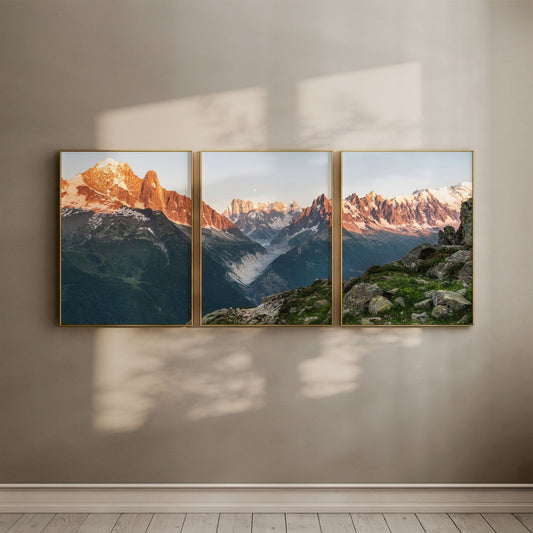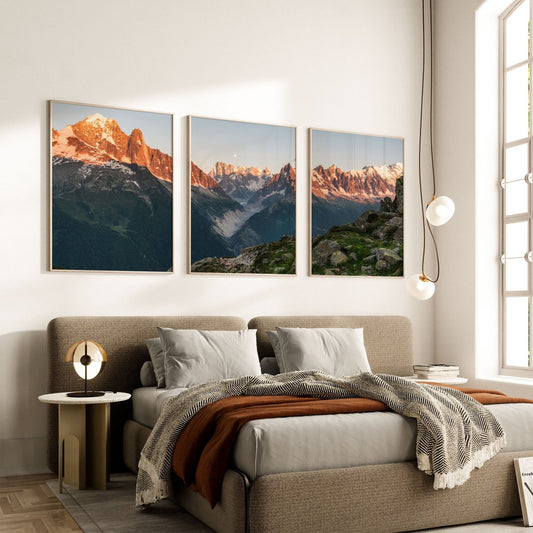The Ultimate Guide to Hanging Artwork in Your Home
Share
When it comes to decorating your home, few elements are as impactful as the art you choose and how you display it. Whether you’re aiming for a gallery-like statement wall or a subtle piece that complements the room’s décor, knowing how and where to hang your artwork is key. Here, we share expert tips and tricks to make your art shine, covering everything from frame sizes to lighting and protection.
1. Consider the Size of the Artwork
Small Frames
-
Best for: Bathrooms, hallways, or spaces above small furniture like a bedside table.
-
Tips: Small frames can look lost on large walls. To avoid this, group them with other small pieces to create a cohesive arrangement.
-
Placement: Hang small art at eye level or just above the feature it’s complementing, such as a shelf or console table. Have you considered just placing them on a shelf?

Medium Frames
-
Best for: Kitchens, home offices, or as part of a gallery wall.
-
Tips: Medium-sized art offers versatility. Pair them with larger pieces in a cluster or let them stand alone in smaller rooms for balance.
-
Placement: Center medium frames at eye level, approximately 57–60 inches from the floor to the centre of the piece.

Large Frames
-
Best for: Living rooms, dining rooms, or above large furniture like a sofa or bed.
-
Tips: Large frames make a bold statement and can anchor a room. Avoid cluttering the space around them to let them breathe.
-
Placement: Leave at least 6–8 inches between the bottom of the frame and the top of the furniture beneath it.
2. Curating Sets and Collages
Pairs of Two
-
Best for: Flanking mirrors, windows, or furniture for symmetry.
-
Tips: Ensure that the frames and art styles are complementary. Use a consistent frame style or color for cohesion.
-
Placement: Align the top edges of the frames for a polished look.
Groups of Three
-
Best for: Staircases, long walls, or above sectional sofas.
-
Tips: Arrange in a linear or triangular pattern. Vary frame sizes slightly to add interest.
- Placement: Leave about 2–3 inches of space between each piece for balance

Collages and Gallery Walls
-
Best for: Large blank walls in living rooms, hallways, or offices.
-
Tips: Plan your layout by arranging the pieces on the floor before hanging them. Use a mix of frame styles and sizes for an eclectic look or uniform frames for a minimalist vibe.
-
Placement: Keep the central point of the collage at eye level for a harmonious display.
3. Highlight or Blend?
|
Making Art a Highlight
|
|
Blending Art into Décor
|
4. Lighting Your Artwork
Natural Light
-
Tips: Avoid placing art in direct sunlight to prevent fading. UV-protective glass or acrylic can help mitigate damage.
Accent Lighting
-
Best for: Highlighting specific pieces in darker rooms or corners.
-
Tips: Use adjustable picture lights, track lighting, or wall-mounted sconces. Aim the light at a 30-degree angle to minimize glare and shadowing.
General Room Lighting
-
Tips: Ensure the overall room lighting complements your artwork. Warm light can enhance the colors in your pieces, while cool light works well for black-and-white prints.
5. Protecting Your Artwork
Framing
-
Tips: Always frame prints and photographs to protect them from dust and humidity. For valuable pieces, consider using museum-grade materials.
Placement
-
Tips: Avoid hanging art in areas with high humidity, such as bathrooms, unless the piece is specifically treated for moisture resistance.
Cleaning
-
Tips: Dust frames regularly with a soft cloth. Avoid using cleaning products directly on glass or acrylic.
6. Final Touches and General Tips
-
Measure Twice, Hang Once: Use a tape measure and level to ensure precise placement.
-
Test the Layout: Before drilling holes, use painter’s tape to outline your frames on the wall to visualize the arrangement.
-
Balance the Room: Consider the scale and proportion of your artwork relative to the room and furniture.
-
Stay True to Your Style: Art is personal. Choose pieces that resonate with you and reflect your personality.
Hanging artwork doesn’t have to be daunting. With thoughtful planning and these tips, you can transform your home into a curated gallery that’s uniquely yours. Happy decorating!






















